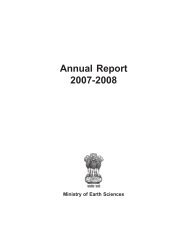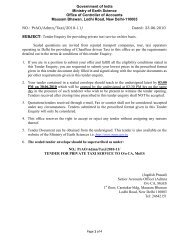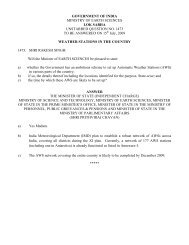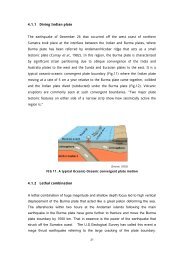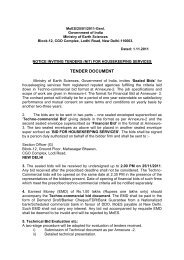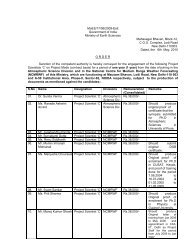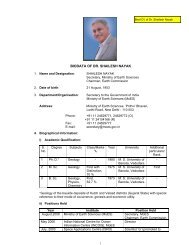1) Microzonation main Volume - Ministry Of Earth Sciences
1) Microzonation main Volume - Ministry Of Earth Sciences
1) Microzonation main Volume - Ministry Of Earth Sciences
- No tags were found...
Create successful ePaper yourself
Turn your PDF publications into a flip-book with our unique Google optimized e-Paper software.
CHAPTER 1INTRODUCTION AND BACKGROUND INFORMATION1.1 GENERAL BACKGROUND<strong>Earth</strong>quakes are one of the most devastating among the various natural hazards. The hazards associated withearthquakes are referred to as seismic hazards. The practice of earthquake engineering involves theidentification and mitigation of seismic hazards. The basis of earthquake geotechnical engineering andmicrozonation is to model the rupture mechanism at the source of an earthquake, evaluate the propagation ofwaves through the earth to the top of bed rock, determine the effect of local soil profile and thus develop ahazard map indicating the vulnerability of the area to potential seismic hazard. In short, the geotechnicalengineer is responsible for providing the structural engineer with appropriate site-specific design groundmotions for earthquake resistant design of structures. Many earthquakes in past have left many lessons to belearned which are very essential to plan infrastructure and even to mitigate such calamities in future. India hasbeen facing threat from earthquakes since ancient times. The planning of cities becomes an important issue ascities are growing and expanding due to increasing migration of people to cities. The role of geological andgeotechnical data is becoming very important in the planning of city urban infrastructure, which can recognize,control and prevent geological hazards (Bell et al., 1987; Legget, 1987; Hake, 1987; Rau, 1994; Dai et al., 1994,2001; Van Rooy and Stiff, 2001). Study of seismic hazard and preparation of geotechnical microzonation mapswill provide an effective solution for city planning. Seismic hazard and microzonation of cities enable tocharacterize potential seismic vulnerability/risk that need to be taken into account when designing newstructures or retrofitting existing ones. Even this will help in designing buried lifelines such as tunnels, waterand sewage lines, gas and oil lines, and power and communication lines.Seismicity of an area is the basic issue to be examined in seismic hazard analysis for evaluating seismic risk forthe purpose of microzonation planning of urban centres. Detailed knowledge of active faults and lineaments andassociated seismicity is required to quantify seismic hazard and risk. Indian peninsular shield, which was onceconsidered to be seismically stable, has shown that it is becoming active. In the last three decades largeearthquakes have caused massive loss of lives and extensive physical destruction throughout the world(Armenia, 1988; Iran, 1990; US, 1994; Japan, 1995; Turkey, 1999; Taiwan, 1999, India 2001, Sumatra 2004,Pakistan, 2005). In India, the recent destructive earthquakes are Killari (1993), Jabalpur (1997), Bhuj (2001),Sumatra (2004) and Indo-Pakistan (2005). Seismic activity of India is clearly evident from these recentearthquakes within the intra plate and also along the boundaries of Indo-Australian Plate and Eurasian Plate.Many researchers address the intra plate earthquakes and seismicity of South India (Purnachandra Rao, 1999;Ramalingeswara Rao, 2000; Iyengar and Raghukanth, 2004).Very preliminary process of reducing the effects of earthquake is by assessing the hazard itself. The seismichazard analysis is concerned with estimate of strong ground motion parameters at a site for the purpose ofearthquake resistant design. The deterministic and the probabilistic seismic hazard analysis are the two basicmethodologies used for this purpose. The complete seismic hazard analysis and microzonation of Bangalore hasbeen carried out using extensive experimental and theoretical work. As part of the national level microzonationprogramme, Department of Science and Technology, Govt. of India has initiated microzonation of Bangaloreregion.1.2 NEED FOR THE STUDYPeninsular India once believed to be a stable continent, has experienced many earthquakes, in particular, Laturearthquake on 30 th September 1993 (M 6.3), Jabalpur earthquake 22 nd May 1997(M 6.0) and Bhuj earthquake26th January 2001(M 7.9). These earthquakes have influenced the need for study of earthquakes and theireffects on Indian cities. As part of the national level microzonation programme, Department of Science andTechnology, Govt. of India has initiated microzonation of Bangalore region. The seismic hazard analysis andmicrozonation of Bangalore region is carried out as part of this project. Apart from this, the specific need tostudy the seismic hazard and microzonation of Bangalore is as follows.Bangalore is densely populated, economically and industrially important city in India. It is one of thefastest growing cities in Asia.The population of Bangalore city is over 6 million and Bangalore city is the fifth biggest city in India.Bangalore is the political capital of the state of Karnataka. Besides political activities, Bangalorepossesses many national laboratories, defense establishments, small and large-scale industries and1





